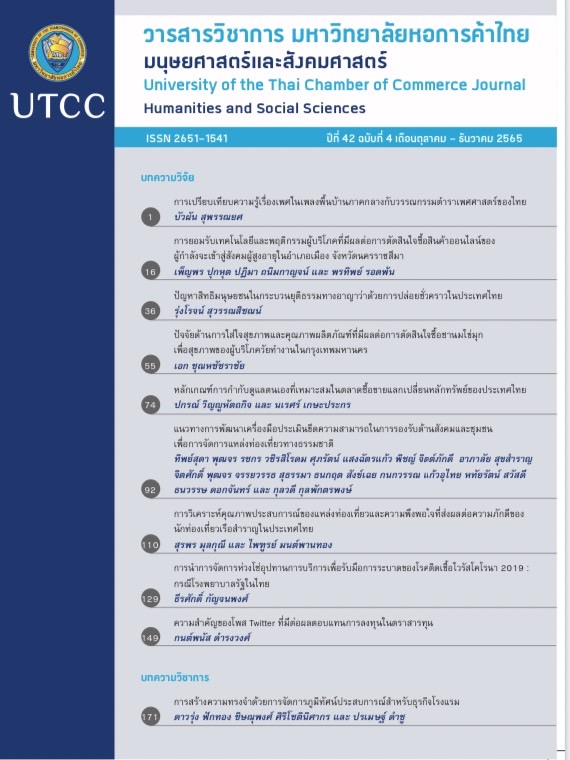การยอมรับเทคโนโลยีและพฤติกรรมผู้บริโภค ที่มีผลต่อการตัดสินใจซื้อสินค้าออนไลน์ ของผู้กำลังจะเข้าสู่สังคมผู้สูงอายุในอำเภอเมือง จังหวัดนครราชสีมา
Main Article Content
บทคัดย่อ
การที่ประชากรไทยก้าวเข้าสู่สังคมผู้สูงอายุ ประกอบกับความก้าวหน้าทางด้านเทคโนโลยีได้มีผลกระทบต่อการดำเนินชีวิต ดังนั้นทุกคนจึงต้องมีการปรับตัว เตรียมความพร้อม และรับมือกับการเปลี่ยนแปลงงานวิจัยนี้มีวัตถุประสงค์เพื่อตรวจสอบและพัฒนาโมเดลเชิงสาเหตุทางการยอมรับเทคโนโลยีและพฤติกรรมผู้บริโภคที่มีผลต่อการตัดสินใจซื้อสินค้าออนไลน์ของผู้กำลังจะเข้าสู่สังคมผู้สูงอายุในอำเภอเมือง จังหวัดนครราชสีมา โดยใช้วิธีการวิจัยเชิงปริมาณ เก็บข้อมูลด้วยแบบสอบถามจากกลุ่มผู้ซื้อสินค้าออนไลน์อย่างน้อย 1 ครั้ง มีอายุไม่น้อยกว่า 55 ปีจำนวน 288 ราย จากผลการวิจัยพบว่า 1) การยอมรับเทคโนโลยีจะมีผลต่อการตัดสินใจซื้อสินค้าออนไลน์ได้ ต้องผ่านพฤติกรรมผู้บริโภคที่เปลี่ยนแปลงไป ตัวแปรพฤติกรรมผู้บริโภคมีลักษณะเป็นตัวแปรคั่นกลางที่สมบูรณ์และ 2) การยอมรับเทคโนโลยีกับวิถีการบริโภคที่เปลี่ยนแปลงทางสังคมยุคดิจิทัลเป็นปัจจัยที่ก่อให้เกิดการปรับเปลี่ยนวิธีการจับจ่ายใช้สอยผ่านช่องทางออนไลน์เพิ่มขึ้น ดังนั้น การปรับตัวและรับมือกับการเปลี่ยนแปลงของผู้ประกอบการ ควรจะมีการออกแบบและปรับปรุงช่องทางการจัดจำหน่ายให้เหมาะสมกับกลุ่มเป้าหมาย รวมทั้งปรับกลยุทธ์การตลาดออนไลน์ให้สอดคล้องกับความต้องการของลูกค้าเพื่อเพิ่มความได้เปรียบในการแข่งขันทางธุรกิจต่อไป
Article Details

อนุญาตภายใต้เงื่อนไข Creative Commons Attribution-NonCommercial-NoDerivatives 4.0 International License.
ลิขสิทธิ์ของบทความ
ผลงานที่ได้รับการตีพิมพ์ถือเป็นลิขสิทธิ์ของมหาวิทยาลัยหอการค้าไทย ห้ามมิให้นำเนื้อหา ทัศนะ หรือข้อคิดเห็นใด ๆ ของผลงานไปทำซ้ำ ดัดแปลง หรือเผยแพร่ ไม่ว่าทั้งหมดหรือบางส่วนโดยไม่ได้รับอนุญาตเป็นลายลักษณ์อักษรจากมหาวิทยาลัยหอการค้าไทยก่อน
เอกสารอ้างอิง
กรมการปกครอง,สำนักบริหารการทะเบียน. (2565).สถิติประชากรรายจังหวัด.สืบค้นเมื่อ17 พฤษภาคม 2565,จาก https://stat.bora.dopa.go.th/StatMIS/#/ReportStat/1
พูนเพิ่ม เสรีวิชยสวัสดิ์. (2562).การพัฒนารูปแบบการยอมรับการใช้เทคโนโลยีของพนักงานในอุตสาหกรรมไมซ์ในประเทศไทย (วิทยานิพนธ์ปริญญาดุษฎีบัณฑิต ไม่ได้ตีพิมพ์). มหาวิทยาลัยศิลปากร, กรุงเทพฯ.
มนตรีพิริยะกุล. (2558). ตัวแปรคั่นกลางและการทดสอบอิทธิพลทางอ้อม. วารสารการจัดการและการพัฒนา, 2(1), 11-31.
วารุณีแก้วกิ่งจันทร์, กนกกาญจน์ เสน่ห์ นมะหุต, และสุพรรณีบัวสุข. (2564). รูปแบบการดำเนินชีวิตของผู้สูงอายุที่ส่งผลต่อการใช้นวัตกรรมการสื่อสาร. เอกสารโครงการนำเสนอผลงานวิชาการระดับชาติ ประจำปีพ.ศ.2564, วันที่1 เมษายน 2564.สืบค้นจากhttp://www.bec.nu.ac.th/npsc/files/16%20254-263-A023.pdf
วุฒิกร บุญลือ, และพัชร์หทัย จารุทวีผลนุกูล. (2562). การยอมรับเทคโนโลยีและส่วนประสมทางการตลาดที่ส่งผลต่อความพึงพอใจในการใช้แอปพลิเคชันซื้อขายเกษตรอินทรีย์ของกลุ่มลูกค้าในประเทศไทย.วารสารวิชาการการตลาดและการจัดการ มหาวิทยาลัยเทคโนโลยีราชมงคลธัญบุรี, 6(2), 1-16.
สารัช สุธาทิพย์กุล, และพิทักษ์ ศิริวงค์. (2560). สภาพปัญหา และการเรียนรู้การใช้เทคโนโลยีของผู้สูงอายุกรณีศึกษา ผู้สูงอายุที่ใช้สมาร์ทโฟนในพื้นที่บริเวณโดยรอบพระปิ่นเกล้า เขตบางกอกน้อย จังหวัดกรุงเทพมหานคร (วิทยานิพนธ์ปริญญามหาบัณฑิต ไม่ได้ตีพิมพ์). มหาวิทยาลัยศิลปากร, กรุงเทพฯ.
สำนักงานพัฒนาธุรกรรมทางอิเล็กทรอนิกส์. (2564ก). รายงานผลการสำรวจพฤติกรรมผู้ใช้อินเทอร์เน็ตในประเทศไทย ปี2564.สืบค้นเมื่อ7 พฤษภาคม 2564,จากhttps://www.thaipdf.com/2151-thailand- internet-user-behavior-2021/
สำนักงานพัฒนาธุรกรรมทางอิเล็กทรอนิกส์. (2564ข). ETDA เผยโควิด-19 เป็นเหตุสังเกตได้Gen Z ใช้เน็ตสูงสุด ปีแรก ชนะ Gen Y แชมป์6 สมัย. สืบค้นเมื่อ 7 พฤษภาคม 2564, จาก https://www.etda.or.th/th/pr-news/ETDA-released-IUB-2021.aspx
สำนักงานสถิติแห่งชาติ. (2564). การสำรวจประชากรสูงอายุในประเทศไทย พ.ศ. 2564. กรุงเทพฯ: ผู้แต่ง.
สุธาสินี ตุลานนท์. (2562). การยอมรับเทคโนโลยีที่มีผลต่อการตัดสินใจซื้อสินค้าออนไลน์ของผู้สูงอายุ(วิทยานิพนธ์ปริญญามหาบัณฑิต ไม่ได้ตีพิมพ์). มหาวิทยาลัยนเรศวร, พิษณุโลก.
อรุโณทัย พยัคฆงพงษ์. (2560). แบบจำลองการยอมรับเทคโนโลยีในการแข่งขันทางการตลาด. วารสารวิชาการมหาวิทยาลัยธนบุรี, 11(25), 128-136
Aggelidis, V. P., & Chatzoglou, P. D. (2009). Using modified technology acceptance model in hospitals. International Journal of Medical Informatics, 78(2), 115-126.
Chu, A. Z.-C., & Chu, R. J.-C. (2011). The intranet’s role in newcomer socialization in hotel industry in Taiwan-technology acceptance model analysis. The International Journal of HumanResource Management, 22(5), 1163-1179.
Hair, J. F., Black, W. C., Babin, B. J., & Anderson, R. E. (2010). Multivariate data analysis: A global perspective (7th ed.). Upper Saddle River, NJ: Pearson Education
Hausman, A. V., & Siekpe, J. S. (2009). The effect of web interface features on consumer online purchase intentions. Journal of Business Research, 62(1), 5-13. doi:10.1016/j.jbusres. 2008.01.018
Hoyer, W. D., & MacInnis, D. J. (2010). Consumer behavior (5th ed). Mason, OH: South-Western/ Cengage Learning
Kline, R. B. (2011). Principles and practice of structural equation modeling (3rd ed.). New York, NY: The Guilford Press.
Kotler, P., & Keller, K. L. (2014). Marketing management (14th ed.). London, England: Pearson
Kotler, P., Kartajaya, H., & Setiawan, I. (2017). Marketing 4.0. New York, NY: Wiley
Loipha, S. (2014). Thai elderly behavior of internet use. Procedia - Social and Behavioral Sciences,147, 104-110. doi:10.1016/j.sbspro.2014.07.125
Ooi, K.-B., & Tan, G. W.-H. (2016). Mobile technology acceptance model: An investigation using mobile users to explore smartphone credit card. Expert Systems with Applications, 59, 33-46. doi:10.1016/j.eswa.2016.04.015
Richard, M. O., & Chebat, J. C. (2016). Modeling online consumer behavior: Preeminence of emotions and moderating influences of need for cognition and optimal stimulation level. Journal of Business Research, 69(2), 541-553. doi:10.1016/j.jbusres.2015.05.010
Tsai, T.-H., Chang, H. T., Chen, Y.-J., & Chang, Y.-S. (2017). Determinants of user acceptance of a specific social platform for older adults: An empirical examination of user interface characteristics and behavioral intention. PLos ONE, 12(8), e0180102. doi:10.1371/journal. pone.0180102


